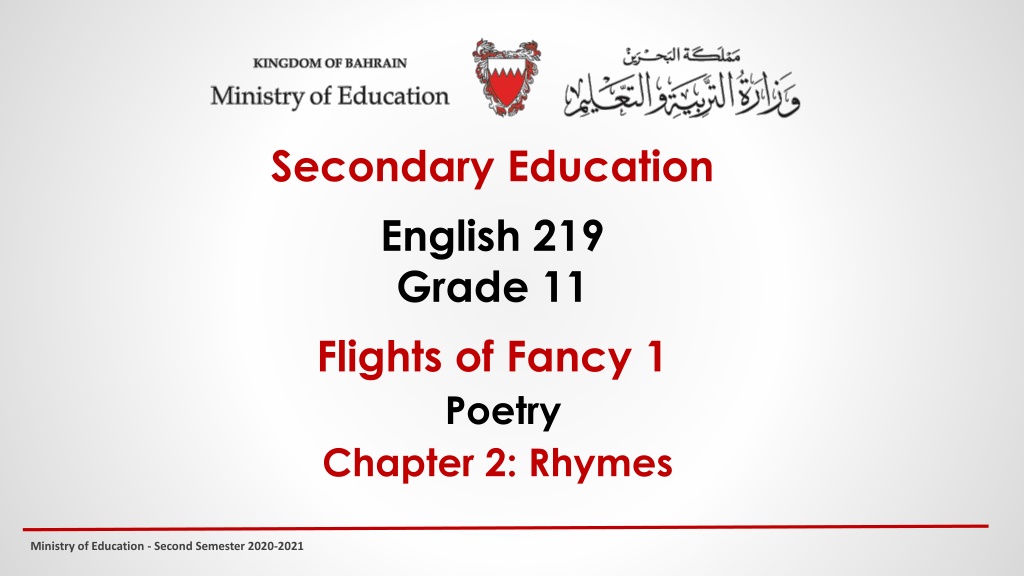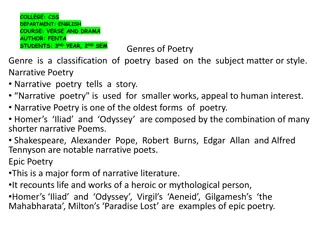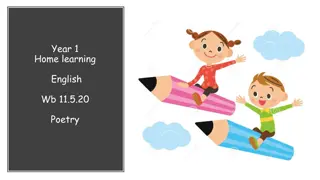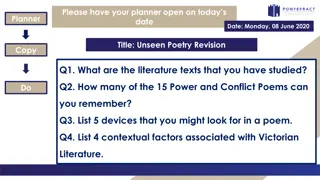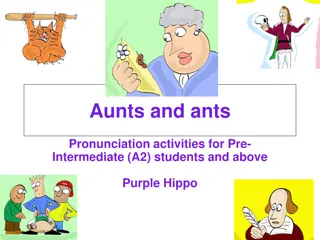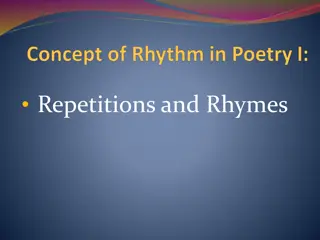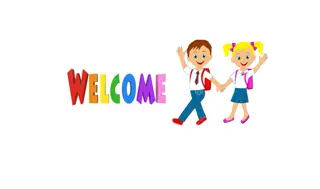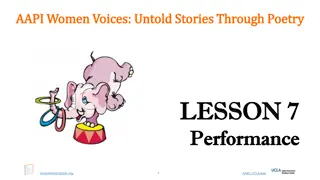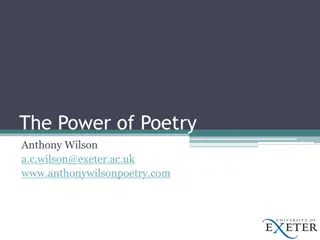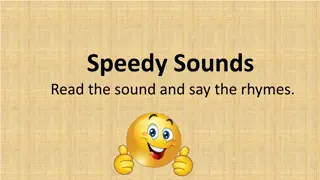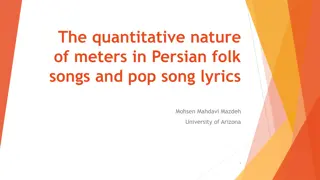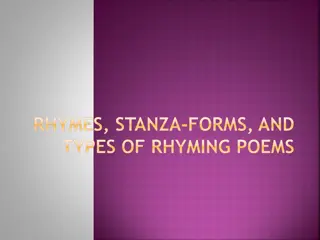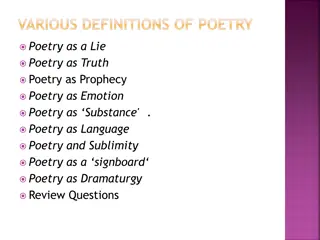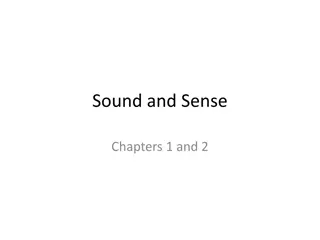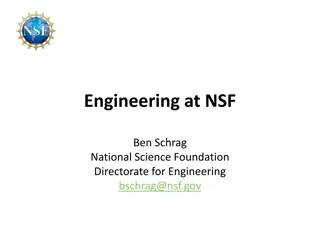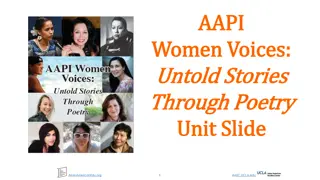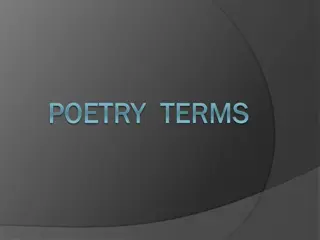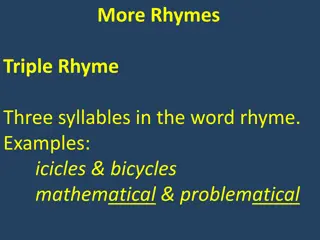Exploring Rhymes in Poetry: Eng. 219 Chapter 2
Understand the importance of rhymes in poetry, learn about poetic elements, and test your knowledge by matching rhyming words. This lesson aims to enhance your comprehension and creativity in writing rhymes. Dive into the world of poetry with Eng. 219.
Download Presentation

Please find below an Image/Link to download the presentation.
The content on the website is provided AS IS for your information and personal use only. It may not be sold, licensed, or shared on other websites without obtaining consent from the author. Download presentation by click this link. If you encounter any issues during the download, it is possible that the publisher has removed the file from their server.
E N D
Presentation Transcript
Secondary Education English 219 Grade 11 Flights of Fancy 1 Poetry Chapter 2: Rhymes Ministry of Education - Second Semester 2020-2021
Eng. 219 - Poetry - Chapter 2: Rhymes Objectives: By the end of the lesson, you will be able: to identify the meaning and importance of rhymes. to demonstrate understanding of rhymes by matching rhyming words. to write a rhyme scheme of a poem. to produce a short rhyming poem. Ministry of Education - Second Semester 2020-2021
WORDS TO LEARN ABOUT POETRY. POETRY is a type of literature that expresses ideas and feelings, or tells a story in a specific form (usually using lines and stanzas) POET the author of the poem, the person who actually wrote it SPEAKER the narrator of the poem, the voice telling us the thoughts/feelings/story FORM the appearance of the words on the page LINE - a group of words together on one line of the poem STANZA - a group of lines arranged together POETIC SOUND EFFECTS - The kind of repetition that most people associate with poetry is the repetition of sounds, in particular in rhyme. Apart from rhyme, there are other sound patterns in poetry which create additional meaning, such as alliteration, assonance and onomatopoeia. Ministry of Education - Second Semester 2020-2021 Eng. 219 - Poetry - Chapter 2: Rhymes
Whats a Rhyme? Rhyme is the repetition of similar sounds in two or more words. In poetry these words are usually at the end of a line and help create a certain rhythm. Most traditional poems use rhyme as a basic device for holding the poem together. Rhyme is the agreement in sound between words or syllables. Poets use rhyme to recall earlier words, to emphasize certain points, and to make their language memorable. In fact, rhymes can be extremely effective in making language take hold in a reader s mind. Example: tree, me, see, be, fleeall rhyme because they end with the same sound. Words sound alike because they share the same ending vowel and consonant sounds. Share the short a vowel sound Share the combined mp consonant sound LAMP STAMP Look at these two words. Ministry of Education - Second Semester 2020-2021 Eng. 219 - Poetry - Chapter 2: Rhymes
Lets check your understanding. Match the rhyming words from the two lists below. 1. squeak ------ peak 1. squeak a) shuttle 2. pray ------ stray 2. pray b) stray 3. sharpen ------ open 3. sharpen c) hour 4. phone ------ stone 4. phone d) boat 5. empower ------ hour 5. empower e) peak WELL DONE! Check your answers 6. helpful ------ cupful 6. helpful f) stone 7. strange ------ range 7. strange g) open 8. motion ------ lotion 8. motion h) range 9. puddle ------ shuttle 9. puddle i) cupful 10. note ------ boat 10. note j) lotion Ministry of Education - Second Semester 2020-2021 Eng. 219 - Poetry - Chapter 2: Rhymes
Here is an example of a poem that uses rhyming: Find the rhyming words. Animal Tao A cat is mostly yin; of the Cosmos she is the twin. Like the mysterious Cosmic Laws, she keeps well-hidden her claws until some urgent necessity. A dog is thoroughly yang, with his boisterous bark and his fang. Ignoring the subtler laws and concealing none of his flaws, he pursues life and cats with avidity. A dog is always searching, but a cat is content with perching. The dog loves to follow his nose, while the cat simply sits there and knows. Activity ends in tranquility. Ministry of Education - Second Semester 2020-2021 Eng. 219 - Poetry - Chapter 2: Rhymes
Check your answers. Animal Tao A cat is mostly yin; of the Cosmos she is the twin. Like the mysterious Cosmic Laws, she keeps well-hidden her claws until some urgent necessity. A dog is thoroughly yang, with his boisterous bark and his fang. Ignoring the subtler laws and concealing none of his flaws, he pursues life and cats with avidity. A dog is always searching, but a cat is content with perching. The dog loves to follow his nose, while the cat simply sits there and knows. Activity ends in tranquility. The words yin and twin rhyme, as well as the words laws, claws and flaws rhyme. Also, necessity, avidity and tranquility as well as nose and knows and also searching and perching rhyme. Ministry of Education - Second Semester 2020-2021 Eng. 219 - Poetry - Chapter 2: Rhymes
However, you should know that there are a number of rhyme forms that deviate from the exact observance of the full rhyme. One talks about a rich rhyme when the consonant before the last stressed vowel is identical: lap/clap, stick/ecclesiastic. When the two rhyme words are in fact the same, it is an identical rhyme. When two rhyme words look and sound the same but have different meanings this is called a homonym. Both rich rhyme and identical rhyme have at times been considered bad form. Sometimes, only the consonantsor only the vowel sounds are identical. In such cases one speaks of half-rhymes, slantrhymes or pararhymes: reader/rider (consonance: same consonants but different stressed vowel) poppet/profit, forever/weather (assonance: same vowels, different consonants) opposite/spite, home/come (eye-rhyme: spelling identical but pronunciation different) The most noticeable rhyme is the rhyme at the end of a line, the end-rhyme. But there are also rhymes within lines, so-called internal rhymes. stick sick / fly- eye : end-rhyme I ve a head like a concertina; I ve a tongue like a button-stick I ve a mouth like an old potato, and I m more than a little sick, B ut I ve had my fun o the Corp ral sGuards: I ve made the cinders fly, And I m here in the Clink for a thundering drinkand blacking the Corporal s eye. Clink rhymes drink inside the same line. internal rhyme. Ministry of Education - Second Semester 2020-2021 Eng. 219 - Poetry - Chapter 2: Rhymes
RHYME SCHEME What s meant by a rhyme scheme? It s a pattern of rhyming words or sounds (usually end rhyme, but not always). Use the letters of the alphabet to represent sounds to be able to visually see the pattern. Look at the following example: a There once was a big fat cat, Cat and sat rhyme, as well as mice and nice. So, the rhyme scheme is a, b, a, b. b That liked to eat cute little mice. a All day he watched while he sat, For those mice that tasted so nice. b Ministry of Education - Second Semester 2020-2021 Eng. 219 - Poetry - Chapter 2: Rhymes
However, if the poem went like this: There once was a big fat cat, a That liked to eat cute little mice. b Cat and sat still rhyme, however, mice and anticipation do not. a All day he watched while he sat, So, the rhyme scheme would be a, b, a, c. Licking his lips in anticipation. c Ministry of Education - Second Semester 2020-2021 Eng. 219 - Poetry - Chapter 2: Rhymes
Function of Rhyme Scheme Rhyme scheme is an integral part of the constitution of a poem, which includes meter, length of phrase, and rhythm. Rhyme scheme, like other writing tools, is used to create balance and relieve tension, manage flow, create rhythm, and highlight important ideas. Its basic function is to form units of sound and suggest units of sense. It also communicates the idea in a more effective way. Ministry of Education - Second Semester 2020-2021 Eng. 219 - Poetry - Chapter 2: Rhymes
Remember: Rhyming lines can be arranged according to different patterns. The same rhymes are marked using small letters of the alphabet. continuous rhyme aaaa bbbb ... rhyming couplets aa bb cc ... alternate rhyme abab cdcd ... embracing rhyme abba cddc ... chain rhyme aba bcb cdc ... tail rhyme aab ccb ... Ministry of Education - Second Semester 2020-2021 Eng. 219 - Poetry - Chapter 2: Rhymes
Remember: Assonance is the repetition of vowel-sounds within non-rhyming words. Consonance is the repetition of consonant sounds within words, but not at the start of a word. Alliteration is the repetition of beginning sounds of words. Find out among the following poems the poem that uses assonance, the poem that uses consonance and the one that uses alliteration. Rend with tremendous Sound your ears asunder, With Gun, Drum, Trumpet, Blunderbuss & Thunder Ladder and bitter Spelled and scald Dress and boss But my grandest creation, as history will tell, Was Firefrorefiddle, the Fiend of the Fell. Ministry of Education - Second Semester 2020-2021 Eng. 219 - Poetry - Chapter 2: Rhymes
Check your answers Rend with tremendous Sound your ears asunder, With Gun, Drum, Trumpet, Blunderbuss & Thunder assonance Ladder and bitter Spelled and scald Dress and boss consonance But my grandest creation, as history will tell, Was Firefrorefiddle, the Fiend of the Fell. alliteration Ministry of Education - Second Semester 2020-2021 Eng. 219 - Poetry - Chapter 2: Rhymes
RHYME SCHEME PRACTICE Find the rhyme scheme for the following poem. Use letters for words that sound alike, or rhyme. Will you walk a little faster? said a whiting to a snail. _____ There s a porpoise close behind us, and he s treading on my tail. _____ See how eagerly the lobsters and the turtles all advance! _____ They are waiting on the shingle will you come and join the dance? _____ Will you, won t you, will you, won t you, will you join the dance? _____ Will you, won t you, will you, won t you, won t you join the dance? _____ You can really have no notion how delightful it will be _____ When they take us up and throw us, with the lobsters, out to sea! _____ But the snail replied Too far, too far! and gave a look askance _____ Said he thanked the whiting kindly, but he would not join the dance. _____ Would not, could not, would not, could not, would not join the dance. _____ Would not, could not, would not, could not, could not join the dance. _____ What matters it how far we go? his scaly friend replied. _____ There is another shore, you know, upon the other side. _____ The further off from England the nearer is to France _____ Then turn not pale, beloved snail, but come and join the dance Ministry of Education - Second Semester 2020-2021 Eng. 219 - Poetry - Chapter 2: Rhymes
Check your answer. Will you walk a little faster? said a whiting to a snail. _____ There s a porpoise close behind us, and he s treading on my tail. _____ See how eagerly the lobsters and the turtles all advance! _____ They are waiting on the shingle will you come and join the dance? _____ Will you, won t you, will you, won t you, will you join the dance? _____ Will you, won t you, will you, won t you, won t you join the dance? _____ You can really have no notion how delightful it will be _____ When they take us up and throw us, with the lobsters, out to sea! _____ But the snail replied Too far, too far! and gave a look askance _____ Said he thanked the whiting kindly, but he would not join the dance. _____ Would not, could not, would not, could not, would not join the dance. _____ Would not, could not, would not, could not, could not join the dance. _____ What matters it how far we go? his scaly friend replied. _____ There is another shore, you know, upon the other side. _____ The further off from England the nearer is to France _____ Then turn not pale, beloved snail, but come and join the dance. A A B B B B C C B B B B D D B B WELL DONE! Ministry of Education - Second Semester 2020-2021 Eng. 219 - Poetry - Chapter 2: Rhymes
Now its your turn. Write a poem using a certain rhyme. Choose one of the following rhyme schemes to write your own quatrain (= a four line poem). aabb (the 1st and 2nd lines rhyme / the 3rd and 4th lines rhyme) abab (the 1st and 3rd lines rhyme / the 2nd and 4th lines rhyme) abcb (only the 2nd and 4th lines that rhyme) aaab (the 1st, 2nd and 3rd lines rhyme, the 4th line has a different rhyme) Ministry of Education - Second Semester 2020-2021 Eng. 219 - Poetry - Chapter 2: Rhymes
Self Assessment: 1 My poem has at least four lines. 2 My poem has a meaning (a subject and a theme). 3 My poem has the same rhyme scheme I have chosen. 4 My poem contains sensory words, rhyme, repetition, and mood, which are used in a creative manner. 5 I did my personal best on this task. 6 I have very few, if any, Spelling, Grammar, Punctuation errors can be found in my poem. Ministry of Education - Second Semester 2020-2021 Eng. 219 - Poetry - Chapter 2: Rhymes
This is the end of the lesson. Thank you for paying attention. 2021 - 2020 Eng. 219 - Poetry - Chapter 2: Rhymes
